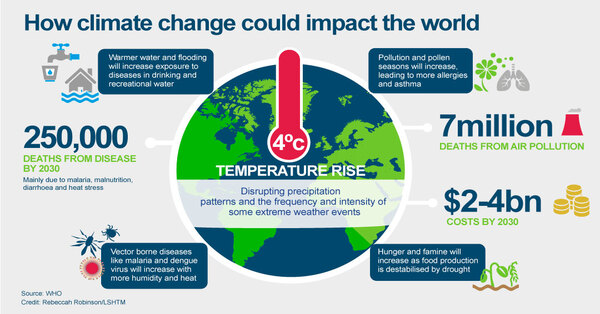Global Warming Affecting Weather Forecast | 03 Oct 2024
Why in News?
Unprecedented warming in 2023-2024 has pushed global temperatures beyond the 1.5ºC threshold, increasing the unpredictability of weather patterns and challenging current forecasting models amid extreme events like heatwaves, cyclones, and floods.
What are the Factors Affecting Weather and Climate Forecasting?
- Global Warming:
- Global warming refers to the long-term increase in Earth's average surface temperature due to human activities, primarily the emission of greenhouse gasses (GHG) like carbon dioxide (CO2) and methane (CH4).
- Impact of Global Warming on Climate Forecasting:
- Increased Unpredictability of Weather:
- Rising global temperatures decrease weather predictability, reducing forecast accuracy by about one day per celsius increase.
- Rising temperature is also complicating current forecasting models to accurately predict extreme events such as heatwaves, hurricanes, monsoons and El Niño.
- Rising global temperatures decrease weather predictability, reducing forecast accuracy by about one day per celsius increase.
- Changes in Atmospheric Dynamics:
- Rising temperatures accelerate the growth of atmospheric eddies- small-scale circulations in the troposphere which impact weather systems.
- This faster growth reduces the memory of initial conditions in weather models, leading to a narrower window for accurate predictions, especially in warming regions.
- Rising temperatures accelerate the growth of atmospheric eddies- small-scale circulations in the troposphere which impact weather systems.
- Impact on Forecasting Models:
- Lorenz's "butterfly effect:
- It shows that small changes in temperature, humidity, and wind can lead to significant impacts on climate forecasting.
- Lorenz's "butterfly effect:
- Increased Unpredictability of Weather:
- Other Factors:
- Data Quality and Availability:
- Accurate forecasts depend on comprehensive and high-quality data. Gaps in data may hinder the ability to make precise predictions.
- Model Limitations:
- Climate models, while sophisticated, have inherent limitations as they often struggle to replicate historical trends and can produce varying results based on their configurations.
- Natural Variability:
- Weather patterns are influenced by natural phenomena such as El Niño, La Niña, and the Indian Ocean Dipole (IOD) which further complicates predictions.
- Data Quality and Availability:
Read More: World's Oceans Approaching Critical Acidification Level, Rising Global Temperatures.
UPSC Civil Services Examination, Previous Year Questions (PYQs)
Prelims
Q1. Which of the following statements is/are correct about the deposits of ‘methane hydrate’? (2019)
- Global warming might trigger the release of methane gas from these deposits.
- Large deposits of ‘methane hydrate’ are found in Arctic Tundra and under the sea floor.
- Methane in atmosphere oxidises to carbon dioxide after a decade or two.
Select the correct answer using the code given below.
(a) 1 and 2 only
(b) 2 and 3 only
(c) 1 and 3 only
(d) 1, 2 and 3
Ans: (d)


